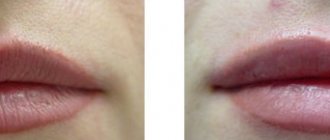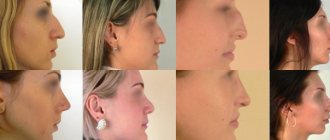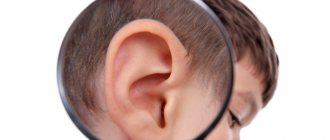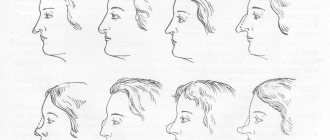- What is an earlobe
- What do patients ask for?
- Correction of earlobes with fillers
- Preparing for surgery
- Anesthesia
- Operation
- Postoperative period
- Contraindications
- Possible complications
- Video
Earlobe correction surgery is performed to eliminate congenital defects or acquired deformities of the lower third of the auricle. It can be performed as an independent procedure or, if necessary, as part of otoplasty.
Outer ear
What do patients ask for?
Earlobe rupture
- Torn earlobe
With such a defect, women turn to plastic surgeons because the earring was pulled strongly or it got caught on something, which is why the rupture occurred.
Some women, due to shock or fear of surgery, do not turn to specialists, hoping that the lobe will heal on its own. However, in this case, there is a very high risk that it will heal, but will not heal or will heal unsightly with a visible scar.
- Too big holes in the earlobes
Hole in the ear after the tunnel
Women who, due to frequent and prolonged wearing of heavy earrings, have developed large holes in their ears, turn to specialists for help. Those who once succumbed to the fashion for tunnels in the ears (so-called “punches”) also face the need to eliminate large holes.
The natural desire of such patients is to reduce (remove) these holes and have the opportunity to pierce their ears again in the future.
- Droopy earlobes
Adult women are most susceptible to this defect, because with age the subcutaneous fatty tissue of the earlobes decreases, they become thinner and become less full. Due to sagging and loss of elasticity, the lobes sag (ptosis is observed), and wrinkles form.
- Asymmetry of the earlobes
- Consequences of a facelift
They can occur after a facelift, when the surgeon removes excess skin. As a result, the lobes are pulled towards the ears, and the face takes on a completely inharmonious appearance.
- Absence or insufficiency of the lobe
- Desire to change the shape, size or volume of the lobes
- Presence of rough scars in this area
- Elimination of protruding lobes
Correction of earlobes with fillers
Correction methods
In terms of time, earlobe reconstruction can take from 20 minutes to 1-2 hours. It all depends on the volume and complexity of the work, as well as the skill of the surgeon himself.
In most cases, a laser scalpel is used instead of a conventional scalpel. It allows capillaries to be sealed during surgery to avoid severe bleeding, and also to make very even cuts, which significantly speeds up healing.
Suturing the tear
Most often, this operation is performed in the first hours after injury. The rupture bleeds heavily, so patients usually do not delay a visit to the hospital. This is great because a fresh wound will heal much faster, especially if it has smooth edges.
The surgeon carefully treats the lobe with an antiseptic, numbs the working area and closes the tear with neat cosmetic stitches. The sutures are removed within 4-5 days, but complete healing occurs in about a month. The entire procedure rarely takes more than 15-20 minutes.
Repair after tunnels
It can last quite a long time, especially if their diameter is 3 centimeters or more. In this case, simply suturing the lobe is not enough. The skin is overstretched and often very thin. Sometimes you have to excise its excess, and then actually form a new lobe from the remnants.
In the first days, patients often complain of loss of sensitivity. This is normal, since it takes some time to restore capillary circulation and damaged nerve endings. Complete rehabilitation will require from 1 to 3-4 months.
Lobe reduction
It is most often performed by simply cutting away excess tissue. Before the operation begins, special markings are made on the ear with a medical marker. Using it, the doctor cuts out a new shape of the lobe, and tightens the edges of the wound with very small cosmetic self-absorbing sutures.
The same manipulations are performed when the lobe is adjusted after wearing heavy earrings for a long time. If necessary, the puncture site may be lightly sutured if it has acquired the shape of an oval or a long slit. In this case, the ear heals very quickly; complete recovery takes up to two weeks.
Elimination of scars and scars
Scar tissue is very dense and the only way to remove it is by excision or laser evaporation. Ablation (evaporation) is considered a non-surgical technique, but it can only cope with minor skin changes. If the scars are too rough and extensive, the surgeon cuts off the keloid tissue and closes the wound by stretching the intact skin of the earlobe over it.
If the remaining skin is not enough, a flap can be used, which is taken from behind the ear or from the inside of the shoulder. When transplanting, there is always a small risk of implant rejection, even if it is the patient's own tissue.
The wound requires very careful care, strict adherence to sterility and the use of antibacterial drugs.
Preparing for surgery
The preparation is simple. First, the patient visits the doctor for a visual examination. The specialist necessarily studies the patient’s medical history, draws up a general picture of his health and prescribes the necessary tests and examinations (blood tests, ECG, etc.). If no contraindications are identified, the day of surgery is set.
Your doctor should tell you what you should not do before and after surgery. General requirement: two weeks before plastic surgery, you need to stop drinking alcohol and smoking.
Deformation after tunnels: is there an alternative to surgery?
One of the most pressing issues concerns the inevitability of reconstructive surgery after wearing tunnels. Patients are interested in whether it is possible to correct the earlobe without surgery; can “holes after tunnels” heal on their own?
Plastic surgeons give a universal answer to this question: if the diameter of the hole is no more than 1 centimeter, you can expect that over time it will become smaller, but will not completely close. If the diameter of the hole is more than a centimeter, you need to have surgery or put up with a noticeable cosmetic defect for the rest of your life.
Operation
Result of sagging lobe plastic surgery
The surgical technique depends on what defect of the lobe needs to be eliminated:
- sagging (lengthening). The surgeon makes an incision on its inner side, through which the fatty tissue is redistributed. He then excises excess skin;
- gap Restoration involves suturing the edges of the defect using interrupted sutures. The same technique is also used for congenital cleft lobes using, if necessary, additional plastic material. Micro-resurfacing of the skin is used to correct scars;
- protrusion. The surgeon removes part of it, excises the skin behind the ear and displaces the cartilage at the bottom of the auricle;
Lobe immediately after surgery
- complete absence. The plastic surgeon recreates it using tissue in the area of the auricle in the form of flaps on a feeding pedicle. In some cases, they resort to a free transplant of a graft, which is taken from the lobe of a healthy ear;
- too small or large size, asymmetry, etc. To surgically correct such congenital problems, excess tissue is excised and the size and volume are adjusted;
- a rough scar on it. It is first excised and then sutured using a special atraumatic material. This does not lead to the formation of new scars; for the best aesthetic result, laser resurfacing can be prescribed.
Once the surgery is complete and cosmetic stitches have been applied, the surgeon will cover the patient's earlobe with a small bandage to avoid complications.
Contraindications
No matter how simple ear surgery is, it also has its contraindications. Surgical correction is not performed if:
- blood clotting disorders;
- fungal and skin infections on the ears;
- any active inflammatory processes;
- exacerbation of chronic ENT diseases;
- systemic infections in the body;
- oncology and autoimmune diseases;
- tendency to form scars;
- serious endocrine disorders;
- cardiovascular failure.
Women do not undergo surgery during pregnancy, breastfeeding or menstruation. Weakened immunity significantly increases the healing period, so it is better to restore it in advance.
CO2 laser earlobe correction
This technique is used if the earlobe was pierced in the wrong place. The procedure is also used if the earlobe is stretched because heavy earrings were worn.
If the hole in the ear does not heal for a long time, then the skin must be exposed to a CO2 laser. Point trauma to tissue occurs, due to which the process of cell regeneration starts, the puncture site tightens and heals. In the future, you can make a new puncture.
CO2 laser correction is very popular today and is widely used to correct many cosmetic imperfections, since the procedure is safe and leaves virtually no traces. The procedure should only be performed by a qualified professional at a medical center or clinic.
When may earlobe suturing be necessary?
- You wore tunnels and decided to heal them, returning your ear to as natural a shape as possible.
- While stretching the tunnels, the lobe broke, you want to restore it and pull it further.
- Heavy earrings weighed down your ears.
Many people decide to sew up the earlobe after they get caught in an earring: even with a slight tug, you can tear the tissue.
Possible complications
Earlobe plastic surgery can cause complications, which the doctor must familiarize the patient with. These include the formation of scars, which can occur both due to the careless work of the surgeon, and due to the individual reaction of the patient’s body. Infection during surgery is a consequence of poor-quality services provided and is usually cured by taking antibiotics. More serious complications may result from the patient having contraindications to surgery that he hid or that the doctor did not identify. Any operation has a small percentage of unexpected reactions of the body. It is necessary to follow all the doctor’s recommendations and come regularly for examination or dressing changes.
How is ear correction performed with fillers?
Contour plastic surgery of the earlobe does not require special preparation. The procedure is performed with a syringe with an ultra-thin needle that does not injure the skin. Depending on the problem, 1 or 2 injections are required. The work algorithm of a cosmetologist doctor is simple:
- Marking the points where filler will be injected.
- Antibacterial skin treatment.
- Local anesthesia.
- Introduction of gel with hyaluronic acid.
- Massage to create the desired shape.
In the first 1-2 weeks after the session, you should avoid visiting baths and saunas. For daily washing, use antiseptic agents recommended by your doctor. The cost of earlobe contouring with fillers depends on the amount of the drug needed for correction. The effect lasts up to 2 years.
If you begin to notice signs of aging on your ears, make an appointment with a specialist at BL. We will help you regain your youth and become more beautiful.
How is lobe reconstruction performed?
- You take off the jewelry and turn to the master.
- The master collects anamnesis, finds out if there are any allergies to medications, and talks about how the procedure will go.
- On the day of surgery, you should not drink alcohol or energy drinks or take blood thinners.
- You come for the procedure, the master administers local anesthesia and begins the reconstruction process - sewing up the ear.
- Be prepared that in the case of tunnels, some of the skin will have to be removed so that the lobe looks as natural as possible after suturing.
After reconstruction, you follow the specialist’s recommendations and treat your ear regularly.










